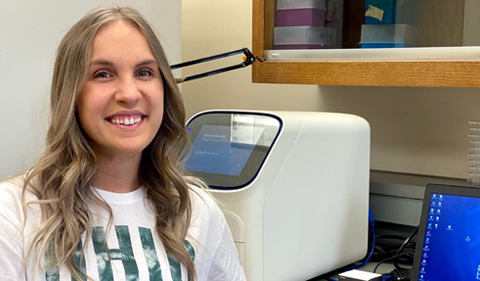The Molecular and Cellular Biology Seminar series features Emily Davis discussing “The Benefits and Drawbacks of Drug Combinations in Cancer Treatment” on March 30 from 4:35 to 5:55 p.m.
- Contact Dr. Sarah Wyatt, MCB director, for Teams information.
Davis is a graduate student in Biological Sciences at Ohio University and a member of the Molecular and Cellular Biology program.
Abstract: Combinations of individually active therapeutic agents, referred to as drug cocktails, are frequently used in clinical settings to amplify the patient’s response to therapy and diminish the likelihood of acquiring resistance to therapy.1 Drug cocktails can increase the efficacy of cancer treatment while allowing lower doses of each individual drug to be used, thereby reducing toxicity.1,2 However, in approximately 66% of drug cocktails, the therapeutic benefit to the patient is only equivalent to that of the single most effective drug in the cocktail. In the remaining 33% of cases, the drugs in the cocktail work synergistically to significantly increase the therapeutic benefit to the patient and improve their prognosis.1 Gao, et. al, have identified one such drug cocktail, consisting of a chemotherapy drug, an anti-cerebral vasospasm drug, and an anti-allergy drug. They designed this cocktail to treat glioblastoma multiforme (GBM), which is the most common and most aggressive brain tumor in adults. To ensure that all three drugs were necessary to exhibit the cocktail’s synergistic effects, Gao, et. al tested each drug individually, as well as all possible combinations of two drugs, and found that nothing produced as significant of a beneficial effect as the full cocktail. In both in vitro and patient-derived xenograft mouse models, their cocktail effectively reprogrammed GBM cells into neuronal cells.3 Synergistic drug cocktails, such as the one developed by Gao, et. al, will likely play a significant role in the immediate future of cancer treatments, as the development of new drugs is both time-consuming and costly.
Key References
- Palmer, A.C., Sorger, P.K. (2017). Combination Cancer Therapy Can Confer Benefit via Patient-to-Patient Variability Without Drug Additivity or Synergy. Cell 171, 1678-1691.
- Wang, H., et. al (2020). Biomaterial-based scaffold for in situ chemo-immunotherapy to treat poorly-immunogenic tumors. Nature Communications 11, 5696.
- Gao, L., et. al (2019). Suppression of glioblastoma by a drug cocktail reprogramming tumor cells into neuronal-like cells. Scientific Reports 9, 3462.




















Comments